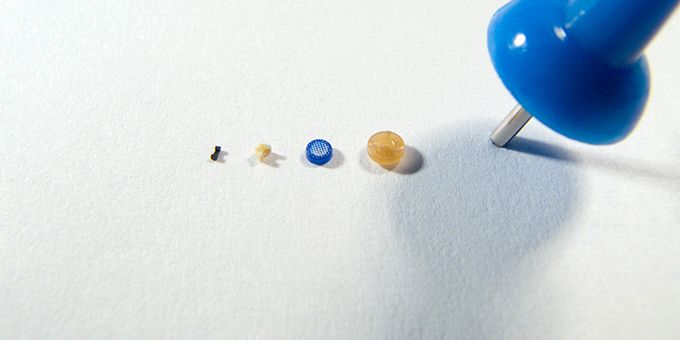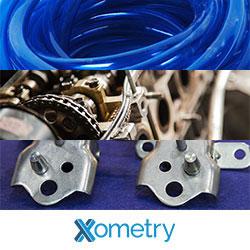When manufacturing micro parts and components, it takes a coordinated team of experts in design, materials, tooling, molding, validation, and automated assembly to successfully manufacture customer parts at high volume.
 Tolerance Attainment in Micro Molding
Tolerance Attainment in Micro Molding

Aaron Johnson, VP of Marketing and Customer Strategy, | Accumold
Much is made of the need for manufacturers embarking on a micro molding project to partner with experienced and highly capable specialist micro molders. The trend towards miniaturization across industry is accelerating, and in many sectors increasingly small micro parts and components are used in safety critical applications, so the demand is for micron-level tolerances that can be achieved repeatably and which can be verified to ensure compliance with design intent.
It is only by working with a qualified micro molder that such repeatable tolerance attainment can be assured, and is also the only way that tolerance creep can be arrested at every point in the product development process. The key is to select a partner with experience that has all stages of the product development process under one roof. In the area of true micro molding there are only really a handful of companies that can credibly claim to achieve the level of tolerances required, and even less that can prove true vertical integration.
AN EAGLE EYE ON TOLERANCES
When manufacturing micro parts and components, it takes a coordinated team of experts in design, materials, tooling, molding, validation, and automated assembly to successfully manufacture customer parts at high volume.
When tolerances are measured in microns, it is critical that all involved in the product development process maintain an obsessive focus on mitigating the risk of non-adherence to these tight tolerances. For the uninitiated, the thought of volume manufacturing parts with tolerances sometimes as low as 2 microns may seem the stuff of fantasy, but there are qualified micro molders that do this daily, while at the same time maintaining zero failure rates.
Attention to detail and attention to process is everything, as not only do micro molders need to make tiny parts with tiny features repeatably and attaining micron tolerances, but they need to do this in a cost-effective and timely fashion. The viability of a project in terms of cost and time means the avoidance of multiple design iterations, constant review and change to manufacturing processes, and above all having to recondition extremely expensive and time-consuming micro tools. The key is to ensure that areas where most “variation” in accuracy can occur are managed with absolute focus.
MICRO TOOLING
Micro tooling is perhaps the key to the success of a micro molding project, be that its optimal design or its ultimate fabrication. Tooling for micro molding projects does not require an extrapolation of the rules governing tooling in traditional injection molding. Features in micro molded parts often exceed the allowable tolerances in traditional injection molding, and similar issues are confronted in the areas of venting and tooling mismatch. Micro molders must be in a position to employ an array of molding technologies, including the latest CNC machining technologies, and also — as is often required — EDM
Other tooling issues specific to micro molding are requirements for an understanding of polishing for micro-mold cavities, and the heating and cooling implications when dealing with extremely thin steel inserts that can be negatively affected by temperatures involved in many molding applications.
In addition, as many micro molding applications use high temperature, high performance materials, such as bio-resorbables, liquid crystal polymers, and PEEK, it is necessary to use and understand the nature of tooling materials such as stainless steel rather than traditional tool steels which may not be able to withstand the high temperatures necessary, and can corrode.
When looking at tolerance creep, if tool design and fabrication is not optimal, then the project may be lost at this stage. Tooling is a true enabling technology when micro molding, and the ability to fabricate tools significantly within final tolerance requirements of a part and to accommodate tolerance loss in other areas of product development is vital but beyond all but the most experienced of micro molders.
MICRO MOLDING
When micro molding, the achievement of truly exacting and sometimes almost impossibly tight tolerances are key drivers. When micron tolerances matter, suddenly the customer and micro molding provider must enter into a different and closer partnership in product development, and it becomes hugely important that the micro molder owns, manages, develops, and innovates in every aspect of the supply chain.
The vagaries of molding at the micro level mean that it is not as simple as just pressing a series of pre-programmed buttons and sitting back and expecting optimal results What you can do at the micro scale is not just what you do at the macro scale but smaller. When micro molding, and when being constantly pushed to manufacture tinier and tinier parts with more and more exacting features, the skill comes from tinkering with the molding machines that you have at your disposal, making your own technology solutions, and also a degree of educated and intelligent trial and error when it comes to the variables in the process.
These variables are numerous, but include such things as residence time, injection pressure, mold temperature, etc… An experienced micro molder will manually dial in such variables to optimise the molding process for the specific material and geometric complexity of any given application, and by so doing will be able to keep a lid on tolerance slippage.
Quite obviously, once again, this part of the process also exemplifies the key role of micro tooling in the tolerance attainment equation. Whatever adjustments and fine tuning a micro molder will make to optimise outcomes from the micro molding process per se, ultimately the end result is that high pressure molten plastic will be injected into a tiny cavity, often containing extremely fragile core pins that can obviously deflect or break. The tooling must be able to stand up to this, or all the expertise from the micro molder will be lost.
METROLOGY & VALIDATION
Metrology has a key role to play in any micro molding product development process, and it is vital to use measuring technologies that are able to validate end-use products with feature sizes that are always extremely tiny.
When using any measuring tool, there will always be an inherent variation in the measurement system used. In a micro molding scenario, it is hugely important to establish confidence in the accuracy and reliability of the chosen measurement system(s). While other sources of measurement variation exist, the two key sources are equipment variation (repeatability) and appraiser variation (reproducibility). Reducing repeatability and reproducibility (R&R) variation to the lowest amount possible, gives confidence in detecting variation in the product being manufactured.
Evaluation of the measurement system in terms of Gage R&R should be an important element of any continuous improvement activity, especially with micro molding applications where any variation in the repeatability and reproducibility of the measurement could crucially eat into the low margins for error in terms of tolerance attainment. The evaluation builds trust in the instruments, operators, and processes. An understanding of measurement system variation helps provide a full understanding of the manufacturing process so that it is easier to predict its future performance and ultimately deliver a more consistent product to the customer.
MATERIAL CONSIDERATIONS
Ultimately, material choice has a direct influence on end-use part functionality and it affects tolerance attainment, the achievement of dimensional objectives, and strength parameters. It also has a direct and obvious impact on the cost and timeliness of manufacturing.
Even in macro product design scenarios material selection can be complicated as it is a trade-off between what is best for the functionality of the part or component being designed, and if it is possible to mold it into the shape required. When looking at micro molding applications, however, where limits are often extreme, the issue becomes more complicated.
The typical route to material selection is to match the functional part requirements with material datasheets. However, most datasheets are based on the manufacture of much larger parts, and this will reflect on recommended gate size and flow properties etc…
The central issue is that datasheets, advice from resin suppliers, and part design criteria are all at odds at the micro scale. Material choice is fundamentally affected by a number of important considerations. What environmental conditions will the part need to operate under? Does it need to withstand solder reflow temperatures or other high-heat situations? Does it touch the human body or other bio-materials? Are there lubricity or hydroscopic properties to include or exclude? How much should it cost?
Knowing how a given resin will perform with the desired micro-features on a part or component takes experience. The focus should be on the precise matching of chosen material to the appropriate part geometry, robustness, and performance requirements, as well as tolerance attainment.
SUMMARY
Micro molding projects are by their very nature complicated, and the fact that many require the repeatable attainment of extremely high tolerances demands that there is a collective focus on accuracy when looking at micro tool fabrication, molding, validation, and automation processes. However, material selection and design for micro molding (DfMM) are also hugely important. It is because of this that manufacturers work with micro molders as close to the beginning of the product development process as possible, as accessing expert micro molding design insight early is the key to cost-effective, timely, and right-first-time manufacturing.
Aaron Johnson is the VP of Marketing and Customer Strategy at Accumold. The company has grown to a 130,000 square foot fortified facility designed for assurance of supply, employs over 350 staff, and is a net exporter shipping all over the world every day from its Ankeny, IA, USA facility which runs 24 hours a day, 7 days a week.
The content & opinions in this article are the author’s and do not necessarily represent the views of ManufacturingTomorrow
Comments (0)
This post does not have any comments. Be the first to leave a comment below.
Featured Product

